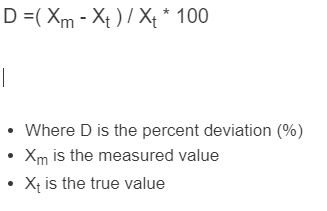Enter the measured value and the true value into the calculator to determine the percent deviation. This calculator can calculator any of the variables given the others are known.
- Percent Error Calculator
- Percentage Difference Calculator
- Relative Error Calculator
- Relative Standard Deviation Calculator
- Percentage Variation Calculator
Percent Deviation Formula
The following formula is used to calculate a percent deviation.
D =( Xm - Xt ) / Xt * 100
- Where D is the percent deviation (%)
- Xm is the measured value
- Xt is the true value
To calculate a percent deviation, subtract the true value from the measured value, then divide by the true value, then multiply by 100.
Percent Deviation Definition
A percent deviation is defined as the percentage difference between a measured value and a true value.
Percent Deviation Example
How to calculate percent deviation?
The following example will provide a step-by-step solution on how to calculate the percent deviation between a measured value and a true known value. In this case, we will be looking at the yield of a chemical reaction.
First, determine the measured value in the experiment. In this case, after a chemical reaction occurs, the amount of substance yielded from the reaction is found to be 50 grams.
Next, determine the true known value. Through chemical analysis, the true expected value of the chemical reaction is known to be 55 grams.
Finally, calculate the percent deviation using the formula above:
D =( Xm - Xt ) / Xt * 100
D =( 50 - 55) / 55 * 100
D = -9.09 % deviation
In general, sometimes the absolute value of the deviation is taken so that the result is always positive. The total percentage deviation does not change, but the negative sign turns to a positive.
FAQ
A percent deviation is the variance of a given value from a known true value presented as a ratio of the percentage of the true value.

